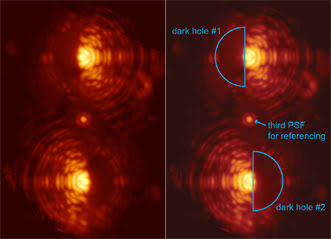A new type of adaptive optic blocks glare from distant suns to give astronomers a glimpse of the dimmer bodies that orbit them closely.
The vector apodizing phase plate (vector-APP) coronagraph was installed in May at the 6.5-m Magellan Clay telescope in Chile, and the first observations demonstrated an unprecedented contrast performance very close to the star, according to an international team of astronomers.

A double image of the star Eta Crucis taken through the vector-APP coronagraph. The two main images of the star exhibit D-shaped dark holes on complementary sides. Courtesy of Leiden University, University of Arizona.
Almost 2000 exoplanets have been detected to date, but only a handful of them have been imaged directly. Exoplanets are typically more than a million times fainter than and are lost in the glare of their parent star, as seen from Earth. To directly image exoplanets and characterize their atmospheres, astronomical instruments at the world's largest telescopes use coronagraphs to suppress the overwhelming halo of light from the star.
The vector-APP coronagraph cancels out starlight using a complex phase pattern that can only be created with advanced liquid-crystal 3D patterning techniques. This technique creates two images of the star with dark, D-shaped regions on either side. In this way, the whole region around the star can be scrutinized for planets.
By combining several layers of liquid crystals, the device can be used over a wide range of wavelengths, including the IR, where the contrast between planet and star is more favorable.
"With this new coronagraph, we are now looking for planets around nearby stars," said Jared Males, a NASA Sagan Fellow at the University of Arizona. "We have the capacity to directly detect, or rule out, planets smaller than Jupiter."
"This new coronagraph technology is also excellent news for the extremely large telescopes currently under construction," said Matthew Kenworthy, an astronomer at Leiden University in the Netherlands. "Thermal infrared instruments such as the mid-infrared E-ELT Imager and Spectrograph (METIS) can exploit this new technology and discover new worlds. With a vector-APP coronagraph in the next generation of telescopes, we can search for planets around nearby stars with unprecedented sensitivity."
The advanced liquid-crystal technology also permitted the production of extreme vector-APP designs that are not possible with more traditional manufacturing technologies. These new designs produce dark holes that cover the full 360° around the target stars. The first data from an experimental device already shows the viability of this novel approach, the researchers said.
Funding came from the William F. and Elizabeth Lucas Junior Faculty Astronomy Award and the NASA Origins of Solar Systems program. The work was performed in part under contract with the California Institute of Technology, funded by NASA through the Sagan Fellowship Program and executed by the NASA Exoplanet Science Institute.
The vector-APP coronagraph devices were developed in collaboration with researchers at North Carolina State University and produced by ImagineOptix Corp. of Raleigh, N.C.
The results were presented at the In the Spirit of Lyot 2015 exoplanet conference in Montreal.